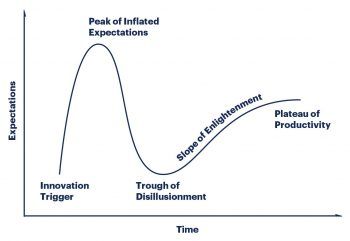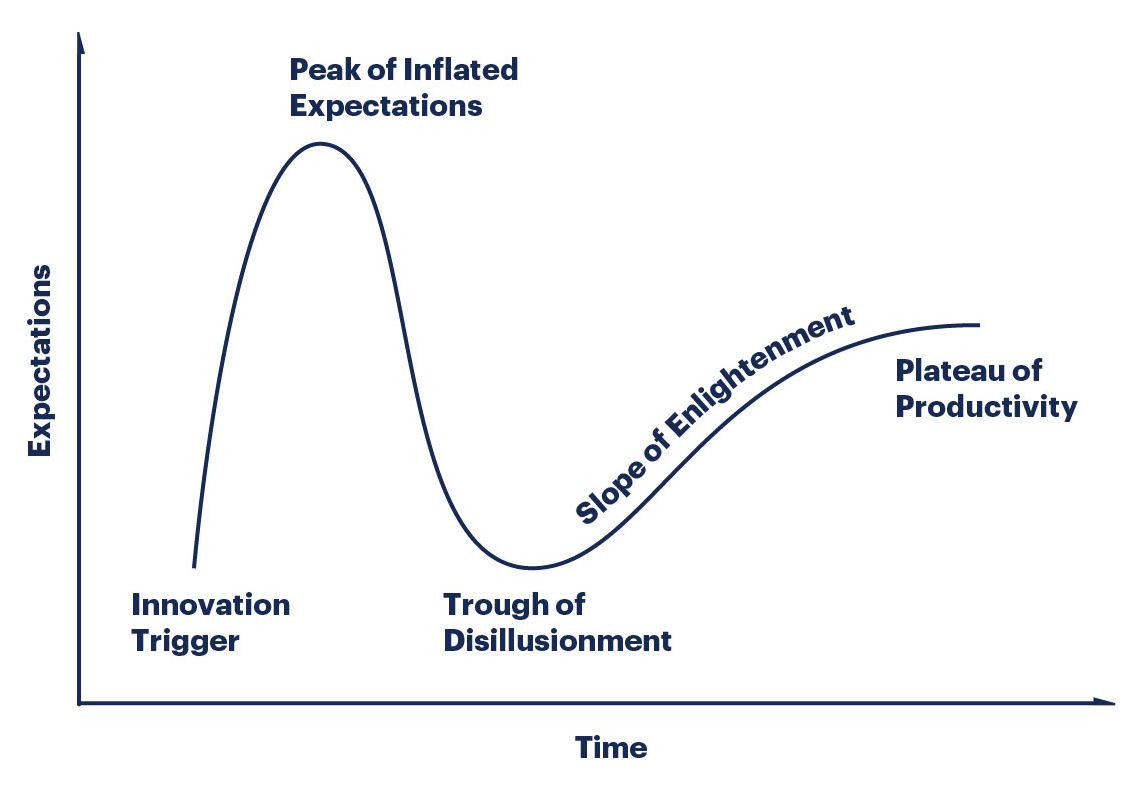
I am sure many of you will have seen the Gartner Hype Cycle at some point. Have you wondered what it’s all about and whether it can help you?
The first time I came across the Hype Cycle, it was a bit of a mystery to me. But I kept going with it and now find it a very helpful and insightful source. It is published annually, so it is not something you need to look at very often, but each year there are new and interesting entrants on the Cycle while others make progress along it. It is worth mentioning that there are different versions for different audiences, but I tend to look at the ‘Emerging Technologies’ version, which is shown.
What technologies will change your industry?
If you think about the technology space today, you will no doubt come up with a number of emerging technologies that everyone is talking about. Will any of them change your industry? Perhaps you consider that many are fads that you can choose to ignore because you know your industry and you know how it works.
I have to tell you that type of thinking is of the past. Remember, Kodak had that perspective about digital photography; they thought it would never catch on. Now it is the new mainstream, and film photography is a tiny niche market. The introduction of that technology enabled many more services and capabilities that they just didn’t imagine.
As I write this in 2018, there are many technologies that everyone is talking about. Blockchain (and the Bitcoin that it enables) is one of the most highly discussed. There is a lot of hype around it; with many people exploring how it might be used in different industries.
A hyped-up listening post
The reality is that the Hype Cycle is just a ‘listening post’. As anyone who has attended our flagship 3-day Product Management and Product Marketing course will know, we believe that Product people need to set up a network of listening posts. Through setting these up, you can establish a flow of useful market insights.
These insights will form the basis of your market analysis and allow you to stay ahead of your competition. And a crucial part of doing that in the technology space is to keep up-to-date on what new and emerging technologies there are, and what they can do.
Technology is not the driver, it’s an enabler
Don’t misunderstand; I certainly do not advocate using new technology for its own sake. That will lead to what I call ‘science projects’ – projects that are technically impressive but that no one wants. But every once in a while you will find a new technology that offers the basis for delivering more value to your customers. Maybe by overcoming a limitation that was there before. Or allowing things to be done quicker and easier. Or breaking through to new customer groups.
To take advantage of this relies firstly on knowing that the technology is there, and understanding its capabilities. Secondly, it relies on you having the insight into how that can change the way you address customer problems, enabled by that new technology.
Have better discussions with technology teams
I should reassure you at this point, I am not advocating that Product Management should be defining the technology to use. But wouldn’t it be nice to have an idea of what you are talking about with your development team? Wouldn’t it be nice to be a step ahead of them for a change (or at least not playing catch-up)? Having that awareness puts you in a position where you can have much more open and constructive conversations about your technology options.
Working collaboratively with a senior (or lead) developer to understand the art of the possible for new technologies can actually strengthen your relationship. They will enjoy the opportunity to discuss new things, and you will gain the much-needed knowledge of how it can help. Then, when it is time to use this new technology, you are already on the same page.
Invest in learning
You might need to invest in experiments or throw-away prototypes to truly understand. It may even be multiple years from when you spot the potential to the point that you can take advantage of it because technology takes time to mature. Potentially in some cases, it might never mature!
For example, I worked on a number of Mixed and Augmented Reality concept projects in the automotive service and repair space when the technology was not quite mature enough to deliver what we wanted.
The potential was obvious though, and the industry interest was huge when we showed our concepts publicly. I hired interns and funded Masters theses to help understand better. I also cultivated relationships with industry leaders and potential partners.
In late 2017, after I had left the industry, I spotted that Porsche had launched a tool for their technicians just like some of the concepts we prototyped.
Spend some time understanding the Cycle
Like any tool, the Hype Cycle needs some knowledge to interpret it. Gartner provides guidance on that so you can check that out directly here.

Gartner Hype Cycle Overview
What does it mean to Product Management?
However, as you will want to consider the phases of the cycle from a Product Management perspective, I propose the following advice.
Innovation Trigger
For most Product people this will be a point to start watching and listening. There won’t be enough detail about the art of the possible yet, so it will be hard to judge if the technology has potential.
Some visionaries and trailblazers (typically with deep pockets) may experiment with the technology here, but this is mostly the domain of technologists. Businesses joining at this point need to be ready for a long journey but have the potential to learn lots, enabling them to be better at using the technology and maybe even influence its evolution.
The Peak of Inflated Expectations
This is the time when most Product people will start to take notice. Leave it too long though, and you might miss an opportunity to lead the market. At this point typically the technology is not mature enough to do what you ‘really’ want it to do, but it might be ‘good enough’ for some applications.
Those early applications might help establish your business as thought leaders in the field, which can be a powerful sales tool later. But beware – people who join at this point are likely to have some failures on the road to success, and the costs will still be quite high.
Trough of Disillusionment
At this point, many businesses who jumped on the bandwagon with all the hype will give up. It has proven to be too hard, too expensive and not delivered the benefits that were promised. This is the critical phase for success, however.
Early market winners and losers are made now, as those who make products that fulfill early adopter needs will emerge as market leaders. You don’t find many new companies coming to the technology at this point, even though it may actually be one of the best times as the kinks are likely to be worked out shortly.
Slope of Enlightenment
If your business is conservative, this is probably when you will start to engage with the technology. You might have been watching for some time and been declaring it is ‘not fit for your purpose’, but now it is turning that corner.
You can now start to deliver on the benefits that your customers want. If you can execute well and fast, you may still be able to position yourself as a leader, but this is your last chance. Maybe you can use the ‘failures’ of the trailblazers against them and you can come across as the people who timed it ‘perfectly’.
Plateau of Productivity
If you are joining the technology journey here, then you are likely to be labeled as a ‘me-too’ product or follower. The market leaders will probably have established themselves, and through competitive pressure on older products aimed at the same space, you will have been forced to bring it into your portfolio. This is precisely how some businesses prefer to operate: they are not positioned to be known for innovation, but instead perhaps for reliability. This isn’t necessarily a bad thing, just a different approach.
Decide when to act
Your organization’s approach to technology adoption will influence when is the right time to get involved. Some businesses will always want to be at the forefront and will have the research budgets to match, probably led by a technology or innovation team. In such cases, Product Management should make sure they are plugged into those activities, mostly in a listening mode so that they can spot when it makes sense to get properly involved. Others will be more conservative, letting other companies do a lot of the heavy lifting in the early phases of evolution of the technology, only to swoop in and take advantage when it is ready. Such companies may be second to market but are hoping to out-execute those who were first.
There is no ‘right’ way globally, but without knowing your organization and what technology options are out there, you won’t be able to make the right choice for your business.
Look for other sources
The Hype Cycle is just one of many possible sources that can be used to monitor the technology space, but because it is backed by Gartner’s reputation it carries a certain level of credibility with senior leaders, which can help your case. Another one that I have found useful is the ThoughtWorks Technology Radar, but there are many more out there. If there are any others you use to monitor the technology, please post them below in the comments.
Start listening to the hype to turn it into insights and customer value.
Phil Hornby
Independent Consultant



Join the conversation - 2 replies
A very interesting article on the hype cycle.
A great read!